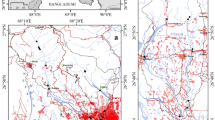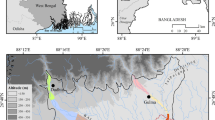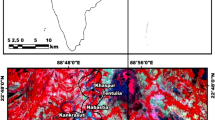Abstract
The sub-Himalayan foothill region is experiencing rapid land-use transformation over the last few decades resulting in the decay of several rivers such as Mahananda, Balason, Sahu, Rakti, Panchanai, Dharala, and Karala. A small rain-fed tributary of Teesta, Karala, has almost decayed in recent years but no notable assessment of its condition has been done to date. This study mainly aims to measure the intensity of human interventions and related responses of Karala through reach-wise, multiple indicator-based assessments. Initially, the reaches have been delineated by segmenting the river into 10 equidistant segments. Characterization of land-use and land-cover has been done for all such reaches. To determine the nature of hydro-geomorphology and water quality of the river 14 indicators are selected and categorized into 3 indices. According to the measured reach-wise mean (Rm), with the highest 4.70 (Reach 1) and lowest 2.21 (R9), it is clear that the need for restoration increases downstream since those areas portray massive deviation from least disturbed conditions (LDC). It is also revealed that the change in the bar area (ID7), vegetation condition (ID3), non-point sources of pollution (NPSP), and channel width (ID8) indicate also an alarming condition within the lower part of the river channel. It is evident that as the river approaches downstream, the natural state of landcover is lost due to intensive human intervention, mostly due to massive land-use transformation reflected in a 600% increase in built-up area in and around the Jalpaiguri region from 1990 to 2020. Hydrologically as well as ecologically sensitive rivers like Karala are the inseparable parts of the sub-Himalayan foothills. Degradation of such, due to, the human alteration would eventually disarrange the entire ecosystem. This easy-to-use, rapid, and coast effective methodology was found useful in distinguishing the extent of alterations by human intervention and the responses of such river systems.

source: SRTM DEM (https://earthexplorer.usgs.gov/). Map prepared by the authors





source: WBPCB (http://emis.wbpcb.gov.in/). Map prepared by the authors

source of pollution at R9. e Several types of bank protection measures at R6. Photographs were taken by the authors in February 2020
Similar content being viewed by others
Availability of data and material
The data or materials used in this article are part of the ongoing research work of the first author, hence not to be shared until its completion. Satellite images used here are freely available; however, the data extracted from these, and used in this article, cannot be shared.
References
Acharjee, M. L., & Barat, S. (2013). Ichthyofaunal diversity of Teesta River in Darjeeling Himalaya of West Bengal, India. Asian Journal of Experimental Biological Sciences, 4(1), 112–122.
Ayaz, S., Biswas, M., & Dhali, M. K. (2018). Morphotectonic analysis of alluvial fan dynamics: Comparative study in spatio-temporal scale of Himalayan foothill, India. Arabian Journal of Geosciences, 11(2), 1–16.
Bandyopadhyay, S., & De, S. K. (2016). Human interference on river health: A study on the Haora River, Tripura. Springer.
Best, J. (2019). Anthropogenic stresses on the world’s big rivers. Nature Geoscience, 12(1), 7–21.
Banerjee, T., & Srivastava, R. K. (2009). Application of water quality index for assessment of surface water quality surrounding integrated industrial estate-Pantnagar. Water Science and Technology, 60(8), 2041–2053.
Bhagat, R. B., & Mohanty, S. (2009). Emerging pattern of urbanization and the contribution of migration in urban growth in India. Asian Population Studies, 5(1), 5–20.
Bhattacharya, P. P. (2011). Poisoning kills fishes in Karala river. The Times of India. https://timesofindia.indiatimes.com/city/kolkata/Poisoning-kills-fishes-in-Karalariver/articleshow/10912682.cms
Brankov, J., Milijašević, D., & Milanović, A. (2012). The assessment of the surface water quality using the water pollution index: A case study of the Timok River (the Danube River Basin), Serbia. Archives of Environmental Protection, 38(1), 49–61.
Bureau of Indian Standards (1992). Water quality standards in India (Source IS 2296:1992). http://117.252.14.242/rbis/india_information/water%20quality%20standards.htm
Campbell, J. B. (1993). Evaluation of the dark-object subtraction technique for adjustment of multispectral remote-sensing data. In Digital image processing and visual communications technologies in the Earth and atmospheric sciences II (Vol. 1819, pp. 176–188). International Society for Optics and Photonics.
Census of India (1991). District statistical handbook: Jalpaiguri District. Directorate of Census Operations, West Bengal.
Census of India (2001). District statistical handbook: Jalpaiguri District. Directorate of Census Operations, West Bengal.
Census of India (2011). District statistical handbook: Jalpaiguri District. Directorate of Census Operations, West Bengal.
Chadwick, M. A., Dobberfuhl, D. R., Benke, A. C., Huryn, A. D., Suberkropp, K., & Thiele, J. E. (2006). Urbanization affects stream ecosystem function by altering hydrology, chemistry, and biotic richness. Ecological Applications, 16(5), 1796–1807.
Chin, A. (2006). Urban transformation of river landscapes in a global context. Geomorphology, 79(3–4), 460–487.
Chin, A., & Gregory, K. J. (2005). Managing urban river channel adjustments. Geomorphology, 69(1–4), 28–45.
Das, A. (2016). Deterioration of Karola River water quality of Jalpaiguri district, West Bengal from 2004 to 2014. Journal of Chemical and Pharmaceutical Research, 8(2), 474–478.
Datta, P. (1998) Migration in India with special reference to Nepali Migration. Department of Economics. University of Calcutta, Kolkata, West Bengal. http://hdl.handle.net/10603/158869
Deb, S., Debnath, M. K., Chakraborty, S., Weindorf, D. C., Kumar, D., Deb, D., & Choudhury, A. (2018). Anthropogenic impacts on forest land use and land cover change: Modelling future possibilities in the Himalayan Terai. Anthropocene, 21, 32–41.
Debnath, M., Ray, S., Islam, N., & Sar, N. (2017). Migration patterns and urban growth in north-east India: A study in Siliguri city. Quest-the Journal of UGC-HRDC Nainital, 11(2), 118–123.
Del Tánago, M. G., Bejarano, M. D., de Jalón, D. G., & Schmidt, J. C. (2015). Biogeomorphic responses to flow regulation and fine sediment supply in Mediterranean streams (the Guadalete River, southern Spain). Journal of Hydrology, 528, 751–762.
Dey, A., Sarkar, K., & Barat, S. (2015). Evaluation of fish biodiversity in rivers of three districts of eastern Himalayan region for conservation and sustainability. International Journal of Applied Research, 1(9), 424–435.
Di Baldassarre, G., Castellarin, A., & Brath, A. (2009). Analysis of the effects of levee heightening on flood propagation: Example of the River Po, Italy. Hydrological Sciences Journal, 54(6), 1007–1017.
Ghosh A. (2018). The importance of Being Siliguri: border effect and the ‘untimely’ city in North Bengal. In: Neilson B., Rossiter N., Samaddar R. (eds) Logistical Asia. Palgrave Macmillan, Singapore.
Goswami, U., Sarma, J. N., & Patgiri, A. D. (1999). River channel changes of the Subansiri in Assam, India. Geomorphology, 30(3), 227–244.
Government of West Bengal (2013). District statistical handbook: Jalpaiguri. Bureau of Applied Economics and Statistics, Department of Statics and Programme Implementation. http://www.wbpspm.gov.in/publications/District%20Statistical%20Handbook
Government of West Bengal (2020). Action plan for rejuvenation of River Karola Jalpaiguri, West Bengal. Municipal Engineering Directorate, Department of Urban Development and Municipal Affairs. https://www.wbpcb.gov.in/files/Mo-02-2020-02-30-30Karola.pdf
Gregory, K. J. (2006). The human role in changing river channels. Geomorphology, 79(3–4), 172–191.
Haghighi, A. T., Marttila, H., & Kløve, B. (2014). Development of a new index to assess river regime impacts after dam construction. Global and Planetary Change, 122, 186–196.
Hajdukiewicz, H., & Wyżga, B. (2018). Hydromorphological changes of a mountain river over the last six decades: case study of the Czarny Dunajec, Polish Carpathians. In 5th Forum Carpaticum.
Hamer, A. M., & Linn, J. F. (1987). Urbanization in the developing world: Patterns, issues, and policies. Handbook of Regional and Urban Economics, 2, 1255–1284.
Henderson, J. V., & Turner, M. A. (2020). Urbanization in the developing world: Too early or too slow? Journal of Economic Perspectives, 34(3), 150–173.
Hu, W. W., Wang, G. X., Deng, W., & Li, S. N. (2008). The influence of dams on ecohydrological conditions in the Huaihe River basin, China. Ecological Engineering, 33(3–4), 233–241.
Huang, X., Liu, J., Zhang, Z., Fang, G., & Chen, Y. (2019). Assess river embankment impact on hydrologic alterations and floodplain vegetation. Ecological Indicators, 97, 372–379.
Jones G.W. (2016). Migration and urbanization in China, India and Indonesia: An overview. In: Guilmoto C., Jones G. (eds) Contemporary Demographic Transformations in China, India and Indonesia. Demographic Transformation and Socio-Economic Development, 5, 271–276. Springer, Cham.
Karmakar, S. (2016). Karala River is going to die due to pollution in Jalpaiguri. Anandabazar Patrika. https://www.anandabazar.com/district/north-bengal/karala-river-is-going-to-die-due-to-pollution-in-jalpaiguri-1.370992.
Keen-Zebert, A. (2007). Channel responses to urbanization: Scull and Mud creeks in Fayetteville, Arkansas. Physical Geography, 28(3), 249–260.
Kiss, T., Fiala, K., & Sipos, G. (2008). Alterations of channel parameters in response to river regulation works since 1840 on the Lower Tisza River (Hungary). Geomorphology, 98(1–2), 96–110.
Knighton, A. D. (1989). River adjustment to changes in sediment load: The effects of tin mining on the Ringarooma River, Tasmania, 1875–1984. Earth Surface Processes and Landforms, 14(4), 333–359.
Kondolf, G. M. (1997). PROFILE: Hungry water: Effects of dams and gravel mining on river channels. Environmental Management, 21(4), 533–551.
Kondolf, G. M., Piégay, H., & Landon, N. (2002). Channel response to increased and decreased bedload supply from land use change: Contrasts between two catchments. Geomorphology, 45(1–2), 35–51.
Kundu, A., & Saraswati, L. R. (2012). Migration and exclusionary urbanisation in India. Economic and Political Weekly, 47(26–27), 219–227.
Liu, X. P., Deng, R. R., Peng, X. J. (2005) A fast atmospheric correction method based on TM imagery. Scientia Geographica Sinica 1.
Macklin, M. G., & Lewin, J. (2019). River stresses in anthropogenic times: Large-scale global patterns and extended environmental timelines. Progress in Physical Geography: Earth and Environment, 43(1), 3–23.
Maparu, T. S., & Mazumder, T. N. (2017). Transport infrastructure, economic development and urbanization in India (1990–2011): Is there any causal relationship? Transportation Research Part A: Policy and Practice, 100, 319–336.
Minnig, M., Moeck, C., Radny, D., & Schirmer, M. (2018). Impact of urbanization on groundwater recharge rates in Dübendorf, Switzerland. Journal of Hydrology, 563, 1135–1146.
Mitra, S., Roy, A. K., & Tamang, L. (2020). Assessing the status of changing channel regimes of Balason and Mahananda River in the Sub-Himalayan West Bengal, India. Earth Systems and Environment, 4(2), 409–425.
Montgomery, M. R. (2008). The urban transformation of the developing world. Science, 319(5864), 761–764.
Padmalal, D., & Maya, K. (2014). Sand mining: Environmental impacts and selected case studies. Springer.
Patra, A. K. (2011). Catfish (Teleostei: Siluriformes) diversity in Karala River of Jalpaiguri District, West Bengal, India. Journal of Threatened Taxa, 3(3), 1610–1614.
Patra, A. K., & Datta, T. (2010). Diversity of cypriniformes fish fauna in Karala river, a tributary of Teesta river at Jalpaiguri district of West Bengal, India. Research Journal of Biological Sciences, 5(1), 106–110.
Paul, M. J., & Meyer, J. L. (2001). Streams in the urban landscape. Annual Review of Ecology and Systematics, 32(1), 333–365.
Paul, M., Gupta, S., & Banerjee, S. (2009). Fish fauna of major rivers of Darjeeling district, with special reference to their conservation status. Rec Zoological Survey of India, 109(4), 15–23.
Picco, L., Comiti, F., Mao, L., Tonon, A., & Lenzi, M. A. (2017). Medium and short term riparian vegetation, island and channel evolution in response to human pressure in a regulated gravel bed river (Piave River, Italy). CATENA, 149, 760–769.
Prasad, S. V. S., Savithri, T. S., & Krishna, I. V. M. (2017). Comparison of accuracy measures for RS image classification using SVM and ANN Classifiers. International Journal of Electrical & Computer Engineering, 7(3), 1180.
Prokop, P. (2018). Tea plantations as a driving force of long-term land use and population changes in the Eastern Himalayan piedmont. Land Use Policy, 77, 51–62.
Rinaldi, M., Wyżga, B., & Surian, N. (2005). Sediment mining in alluvial channels: Physical effects and management perspectives. River Research and Applications, 21(7), 805–828.
Rinaldi, M., Surian, N., Comiti, F., & Bussettini, M. (2013). A method for the assessment and analysis of the hydromorphological condition of Italian streams: The Morphological Quality Index (MQI). Geomorphology, 180, 96–108.
Rinaldi, M., Baena-Escudero, R., Nardi, L., Guerrero-Amador, I. C., & García-Martínez, B. (2019). An assessment of the hydromorphological conditions of the middle and lower Guadalquivir River (southern Spain). Physical Geography, 41(3), 254–271.
Scorpio, V., & Rosskopf, C. M. (2016). Channel adjustments in a Mediterranean river over the last 150 years in the context of anthropic and natural controls. Geomorphology, 275, 90–104.
Shalaby, A., & Tateishi, R. (2007). Remote sensing and GIS for mapping and monitoring land cover and land-use changes in the Northwestern coastal zone of Egypt. Applied Geography, 27(1), 28–41.
Sharma, D., & Kansal, A. (2011). Water quality analysis of River Yamuna using water quality index in the national capital territory, India (2000–2009). Applied Water Science, 1(3–4), 147–157.
Sharp, J. M., Jr., Krothe, J. N., Mather, J. D., Garcia-Fresca, B., & Stewart, C. A. (2003). Effects of urbanization on groundwater systems. Earth Sciences in the City : A Reader, 56, 257–278.
Singh, G. (2021). Choking Mahananda: How Siliguri’s waste, water crisis is turning on its people. Down to Earth. https://www.downtoearth.org.in/news/water/choking-mahananda-how-siliguri-s-waste-water-crisis-is-turning-on-its-people-77846
Singh, M., & Singh, A. K. (2007). Bibliography of environmental studies in natural characteristics and anthropogenic influences on the Ganga River. Environmental Monitoring and Assessment, 129(1), 421–432.
Singh, S. K., Srivastava, P. K., Gupta, M., Thakur, J. K., & Mukherjee, S. (2014). Appraisal of land use/land cover of mangrove forest ecosystem using support vector machine. Environmental Earth Sciences, 71(5), 2245–2255.
Słowik, M., Dezső, J., Marciniak, A., Tóth, G., & Kovács, J. (2018). Evolution of river planforms downstream of dams: Effect of dam construction or earlier human-induced changes. Earth Surface Processes and Landforms, 43(10), 2045–2063.
Surian, N. (1999). Channel changes due to river regulation: The case of the Piave River, Italy. Earth Surface Processes and Landforms: THe Journal of the British Geomorphological Research Group, 24(12), 1135–1151.
Surian, N., Rinaldi, M., Pellegrini, L., Audisio, C., Maraga, F., Teruggi, L., & Ziliani, L. (2009). Channel adjustments in northern and central Italy over the last 200 years. Management and Restoration of Fluvial Systems with Broad Historical Changes and Human Impacts: Geological Society of America Special Paper, 451, 83–95.
Swanson, B. J., Meyer, G. A., & Coonrod, J. E. (2011). Historical channel narrowing along the Rio Grande near Albuquerque, New Mexico in response to peak discharge reductions and engineering: Magnitude and uncertainty of change from air photo measurements. Earth Surface Processes and Landforms, 36(7), 885–900.
Tamang, L., & Mandal, D. K. (2015). Bed material extraction and its effects on the forms and processes of the lower Balason River in the Darjeeling Himalayas, India. Geographia Polonica, 88(3), 393–405.
The Telegraph. (2011). Warning to river polluters — Karala clean-up with Teesta water today. https://www.telegraphindia.com/west-bengal/warning-to-river-polluters-karala-clean-up-with-teesta-water-today/cid/478654
The Telegraph. (2018). Stretch of Teesta turns grave for fish trove. https://www.telegraphindia.com/west-bengal/stretch-of-teesta-turns-grave-for-fish-trove/cid/1453166
Saha, U. D., & Bhattacharya, S. (2019). Reconstructing the channel shifting pattern of the Torsa River on the Himalayan Foreland Basin over the last 250 years Bulletin of Geography. Physical Geography Series, 16(1), 99–114.
Wiejaczka, Ł, Bucała, A., & Sarkar, S. (2014). Human role in shaping the hydromorphology of Himalayan rivers: Study of the Tista River in Darjeeling Himalaya. Current Science, 106(5), 717–724.
Wiejaczka, Ł, Tamang, L., Piróg, D., & Prokop, P. (2018). Socio environmental issues of river bed material extraction in the Himalayan piedmont (India). Environmental Earth Sciences, 77(20), 718.
Wyżga, B., Amirowicz, A., Oglęcki, P., Hajdukiewicz, H., Radecki-Pawlik, A., Zawiejska, J., & Mikuś, P. (2014). Response of fish and benthic invertebrate communities to constrained chanel conditions in a mountain river: Case study of the Biała, Polish Carpathians. Limnologica, 46, 58–69.
Zee News. (2019). Huge boal fish caught from Karala river Jalpaiguri. https://zeenews.india.com/bengali/state/huge-boal-fish-caught-from-karala-riverjalpaiguri_287696.html
Zhao, C., Pan, T., Dou, T., Liu, J., Liu, C., Ge, Y., & Lim, R. (2019). Making global river ecosystem health assessments objective, quantitative and comparable. Science of the Total Environment, 667, 500–510.
Zhou, N. Q., & Zhao, S. (2013). Urbanization process and induced environmental geological hazards in China. Natural Hazards, 67(2), 797–810.
Zope, P. E., Eldho, T. I., & Jothiprakash, V. (2016). Impacts of land use–land cover change and urbanization on flooding: A case study of Oshiwara River Basin in Mumbai, India. CATENA, 145, 142–154.
Acknowledgements
The authors gratefully acknowledge the M.sc 4th-semester students of the Department of Geography, University of Calcutta, and to those who offered logistical support during the fieldwork.
Author information
Authors and Affiliations
Corresponding author
Ethics declarations
Conflict of interest
The authors declare no competing interests.
Additional information
Publisher's Note
Springer Nature remains neutral with regard to jurisdictional claims in published maps and institutional affiliations.
Rights and permissions
About this article
Cite this article
Mondal, S., Mitra, S., Dey, J. et al. Assessment of the anthropogenic interventions and related responses of Karala River, Jalpaiguri, India: a multiple indicator-based analysis. Environ Monit Assess 193, 667 (2021). https://doi.org/10.1007/s10661-021-09467-3
Received:
Accepted:
Published:
DOI: https://doi.org/10.1007/s10661-021-09467-3




